
Why don't more women cycle?
Why don't more women cycle?
Back in 2003 I ran a community project in London called Cycling for Women for the Women's Design Service, a charity which worked on issues that affect women in the built environment. Some of the sound bites I used to promote the project included statistics on how cycling trips are very gender-skewed towards men.
I remember thinking that this situation would have to change in the coming years. Cycling was already experiencing a significant upward trajectory in inner London, the London Underground was crammed to bursting even then, and the new powers that the Mayor of London had over transport surely meant that change could come about soon.
In 2017, despite cycling having grown in London and some other UK cities, it remains very much a minority form of transport: only 2% of journeys are done by bike, compared with 27% in the Netherlands. And the gender split remains skewed.
Transport for London reports that "regular cyclists are more likely to be men, white, working and non-disabled – 20% of men report being 'regular' cyclists compared with 8% of women". In England, men travel on average 86 miles per year by bike compared with an average of 23 for women, while in Scotland more than three times as many men than women commute to work by bike: 2.1% compared with 0.6% (Table DC7101SC).
How does the UK compare to other countries?
But it doesn’t have to be like this. As Puchler and Buehler point out in their seminal paper Making Cycling Irresistible, Dutch, German and Danish women cycle as often as men, and rates of cycling fall only slightly with age.
This is compared with "much of the industrialised world," where women cycle far less than men, "and the elderly hardly cycle at all". The UK and USA are quoted as having a cycling culture dominated by men, where they make 72% and 76% of all bike trips, respectively.
In the Netherlands, although far less heavily skewed, the gender split is the other way around: women make 55% of all cycling trips, while 25% of trips made by over 75-year-olds are done by bike. With 45% of trips taken by women in Denmark and 49% by women in Germany, our European neighbours show that cycling doesn’t have to exclude women to the great extent it does in the UK.
Is the gender imbalance a new thing?
Women in the UK have always lagged behind men in taking up cycling. When the bicycle was first invented, women's clothing prevented us from being able to ride safely – or indeed at all. "Victorians enthusiastically took to the bicycle," explains Dr Kat Jungnickel in her Bikes and Bloomers project, "yet women had to deal with many social, political and material challenges to their freedom of movement."
The bicycle has been credited with starting a revolution in women's clothing as a result, with the invention of bloomers to allow straddling of machine without long skirts getting in the way, as part of the creation of 'Rational Dress' for women.
Nowadays, 79% of women in London report being able to ride a bike, compared with 91% of men, so we are catching up, but we're still behind. However, when Sustrans did a survey in 2013 trying to understand why fewer women than men ride a bike, they found that while 43% of women own a bike, almost eight in 10 never cycled at all and only 4% cycle more than once a week.
Why do women ride much less frequently?
The sad reality is that women are judged more on their appearance than men; thus within the context of cycling being seen as sweaty, nerdy and just a lot of hard work in a hostile environment, the perception is simply going to be that cycling will mess up your appearance. Sustrans' research showed that aside from an intimidating traffic environment, women's other big concerns were age (17%) and lack of fitness (8%), followed by a range of other issues around appearance.
Studies increasingly reveal a confidence – not competence – gap between women and men, generally in many areas of life, which is replicated in the sphere of cycling. Women are more likely than men to describe themselves as ‘inexperienced cyclists', which might go some way towards explaining why women are significantly more likely than men to report considering taking part in cycle training.
But what about attitudes towards cycling by the planners, policy-makers and engineers who design our streets? Material for the Women and Cycling 2015 conference, organised by communications agency Landor, states that "women remain under-represented within the majority of transport planning and engineering teams who design the cycling facilities on our roads". Might this affect the extent to which women's needs are taken into account?
Ruth-Anna Macqueen lives in Hackney, east London. She launched the Family Cycling Library, where families can borrow child seats, trailers and other children's cycling equipment to help them get around by bike as a family. Ruth-Anna laments the lack of awareness of the needs of 'practical cycling' – cycling as a family or carrying things like shopping on your bike – by transport professionals she has talked to.
"There just seems to be zero awareness by so many people working in transport policy that you can cycle with children, that it's a legitimate form of transport for them and for families," she says. This is a gendered issue, because women make more 'escort' trips with children and more shopping trips than men.
"There is such low awareness of how to accommodate trailers, cargo bikes and young children in a safe infrastructure environment. Painted cycle lanes or asking people to 'share the road nicely' just isn't enough. We need more cut-throughs large enough for trailers and out-sized bikes, and properly protected cycle tracks."
In 2014, Dr Rachel Aldred of the University of Westminster undertook the first online survey asking adults about attitudes towards children and cycling. It found that even people happy to ride on busy roads themselves are generally not keen to ride there with eight-year-olds, and riding with children on residential streets was often avoided due to fear of aggressive, rat-running traffic.
What barriers particularly affect women?
This leads us to the main barriers to cycling that especially affect women. Overwhelmingly, whether male or female, fear of traffic comes up again and again as a top reason for not cycling. But this seems to worry women more than men.
Dr Aldred points out that women and men want the same thing when it comes to cycling: a safe environment. However, women are particularly concerned about perceived unsafe conditions.
But there are other factors that affect women more than men. Transport for London's research into barriers to cycling cites "home and family responsibilities" as the main barrier to participation for many Black and Minority Ethnic groups, "particularly for women (responsible for caring for children and other members of the family)".
In addition, there is a particular kind of harassment from other road users that women experience: that of a sexual nature and sexist harassment stemming from indignation that a cyclist – and a female cyclist at that, doubly vulnerable and bold – would dare to get in the way of a driver.
Issues of power and entitlement weave through the narrative of harasser and recipient, as explained by Grace Iggulden, who lives in Vauxhall, London, and cycles daily through central London to Victoria.
"In my experience it's the same type of person again and again who has a sense of entitlement to give you their opinion," she says of the white, middle-aged men who wind down their windows and yell abuse with startling frequency. "They say things like, 'you must be a terrible mother' and 'you're a selfish b**ch'. I deal with it at the time, but sometimes afterwards I am physically shaking with the shock."
We discussed how, on a bike, your choices are more exposed and therefore publicly available to criticism. "In their view, women are expected to behave a certain way, and if you are taking the lane in a large cargobike carrying four children, that displays a level of confidence that some men are simply not comfortable with."
Physically engaged women were seen to have relinquished their feminine roles and responsibilities in exchange for masculine behaviours, attracting responses not fit for publication that require you to have nerves of iron … One needs to be very brave to stand all that
Kat Jungnickel, Bikes and Bloomers
Cycling UK's Victoria Hazael, recalls how she was often criticised by strangers for cycling when she was pregnant. She said: "Often complete strangers would shout 'you shouldn’t be cycling in your condition'. The bigger my bump, the more I had to justify my decision. Most people don't realise that the benefits of cycling outweigh the risks by as much as 20:1 and that sitting at home on the sofa all day long is actually more dangerous!"
As I found back in 2003 in Cycling for Women, these incidents are sadly all too common, and can easily put women off cycling. It seems that less than we think has changed since the late 19th century, when, as Kat Jungnickel explores in Bikes And Bloomers, "physically engaged women were seen to have relinquished their feminine roles and responsibilities in exchange for masculine behaviours," attracting responses "not fit for publication" that require you to have "nerves of iron … One needs to be very brave to stand all that."
Are women more at risk?
Overall, women are slightly less likely to be killed when cycling than men. The Department for Transport says that women make up 20% of all the distance travelled in the UK on bicycles, but only 17% of deaths.
What academic research is there about women and cycling?
The experience of female cyclists facing disproportionate harassment and bad driving was demonstrated in Aldred's Near Miss Project. That women were almost twice as likely as men to be subjected to frightening 'near miss' incidents seemed mainly linked to the lower average speed reported by female respondents, compared with the men who took part.
"If you're cycling more slowly, you potentially do face greater hostility than if you're able to keep up with motor traffic, and not be overtaken quite so much." Aldred explained to The Guardian. The only likely remedy for this, Aldred said, was to build proper cycling infrastructure to separate cyclists from motor traffic.
What women think they need?
If you ask women themselves, these ways forward are borne out. The Sustrans survey found that not feeling safe was the biggest concern women had about cycling, with 67% choosing 'cycle lanes separated from traffic' as the number one thing that will get more women cycling.
Katja Leyendekker is a PhD candidate at Newcastle University with a background as a Chartered Civil Engineer. In her work on women’s voices for spatial fairness she argues that women can probably "be more expressive and more honest in their needs for separation and protection from motor vehicles" – that is, all genders may have a similar view, but women feel more open to admitting it.
What is being done to encourage women to cycle?
In 2007, Cycling UK launched Five Miles to Fabulous, which encouraged the network of member groups and cycle instructors to put on cycle rides for women. With an emphasis away from cycling as sport and encouraging social rides with friends, many women's cycling groups such as Isis Cyclists in Oxford and The Fabulous Ladies in Chester were set up and proved very popular; both groups now have around 200 regular members.
In 2014, Cycling UK developed and supported Belles on Bikes, a network of women's cycling groups in Scotland. The scheme is currently supported by the Big Bike Revival through Transport Scotland funding. It aims to support women to get cycling together in a friendly, inclusive and relaxed environment.
Cycling UK also supports the Women’s Cycle Forum Scotland.
In July, Cycling UK will be celebrating women who cycle and helping those who need extra encouragement to take up cycling through the Women's Festival of Cycling. This UK-wide festival aims to brings together the great things that are already happening, and inspire more women to discover the thrill of riding bikes for themselves – whatever their age, fitness or ability. Groups and individuals can register rides and share ideas and experiences.
Sport and physical exercise can also play its part in tempting women on to bikes. Transport for London found that the fitness angle of cycling may be a good way to highlight its advantages. British Cycling, the governing body for sports cycling in Great Britain, set up the Breeze Network, aimed at encouraging more women to get into cycling. The organisation launched a seven-year 'Women's Strategy' in 2013, aiming to get one million more women on bikes by 2020.
Rides of Way, Cycling UK's report into off-road cycling in the UK, concluded that women were more likely than men to consider way marking, toilets and downloadable maps as important features when cycling away from their homes. Separately, Cycling UK's Julie Rand argued that greater provision for off-road cycling is a feminist issue, as women are disproportionately more likely than men to want to avoid cycling in traffic.
Women's cycling conferences
There have been a number of conferences on the theme of women in cycling, covering cycling as transport as well as sport and leisure. The first Women and Cycling conference was held in York and organised by Landor in 2015. The second was held in Hereford in 2016, organised by Hereford Council and WE Cycle. A Day of Women and Bicycles was organised by the Broken Spoke Co-op in 2016 and by the Adventure Syndicate and Broken Spoke Co-op again in 2017. Cycling UK staff spoke at the Women and Cycling Conference 2017 in Bradford in May, organised by Healthy Life Cycles in collaboration with Bradford Metropolitan Council, which aimed to 'Inspiring more women to cycle more often, to more places'.
All conferences repeatedly returned to the issue of good-quality, safe infrastructure (described by Cycling UK's Space for Cycling campaign) as a gender equaliser.
What is the way forward?
Cycling UK Membership Director Matt Mallinder wants to increase the numbers of women joining and supporting the charity: "Currently 25% of Cycling UK members are female and we would love to see that rise to 50%."
Cycling UK Policy Director Roger Geffen MBE says: "The government wants to normalise cycling by 2040. To do that, they need to create the conditions where women are as likely to cycle as men, and where older people and children are as likely to cycle as their Dutch counterparts. Councils therefore need to make sure they get the maximum benefits for cycling from every investment they make in the road network. Whether it's a new junction design or even the planned resurfacing of a road, they need to design in good cycling conditions right at the outset."
UK cycling conditions deter the vast majority of the population from cycling, yet they disproportionately deter young people, older people, women and people with disabilities from cycling
Roger Geffen MBE, Cycling UK Policy Director
He continued: "UK cycling conditions deter the vast majority of the population from cycling, yet they disproportionately deter young people, older people, women and people with disabilities from cycling. As 'protected groups' under the Equality Act 2010, Cycling UK believes the government has a duty to overcome this deterrent effect by putting in place cycle-friendly design standards based on continental best practice, and making sure these are followed in all highway and traffic schemes, new developments and planned maintenance works. When a road is being resurfaced, that is a wonderful opportunity to redesign it to be more cycle friendly at the same time."
The founder of Islabikes, Isla Rowntree believes that a lack of confidence to fix your own bike is also a barrier. She told London Cycling Campaign recently that: "Almost all adult women have been subjected to gender stereotyping … as a result they are less likely to be confident mechanically." Note: confident, not competent. "I believe we need to make bikes easier to own and use," much like the simple and robust city-bikes common in Holland.
Research by Aldred, Woodcock and Goodman has also suggested that: "Creating a mass cycling culture may require deliberately targeting infrastructure and policies towards currently under-represented groups." It would seem that taking the needs of women seriously could lead to infrastructure improvements that would help grow cycling more generally.
Going back to my Cycling for Women project in 2003, I reflect on how sparsely available data was back then. I remember one respondent to our outreach noting that: "I’ve been cycling in London for over 50 years, and no one has ever asked me how I feel about it." Now there is a plethora of information and research into cycling by women, how we feel, what we need and how to provide it. There is a growing consensus that providing excellent, inclusive protected cycling infrastructure and space for cycling is a key part of the solution, one which will help anyone to take to their bikes.






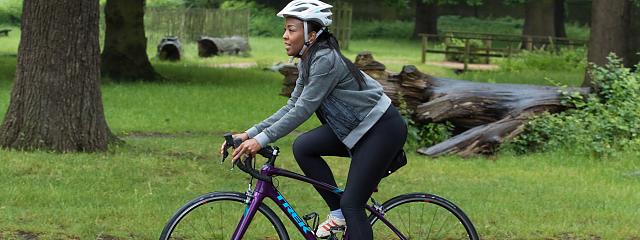
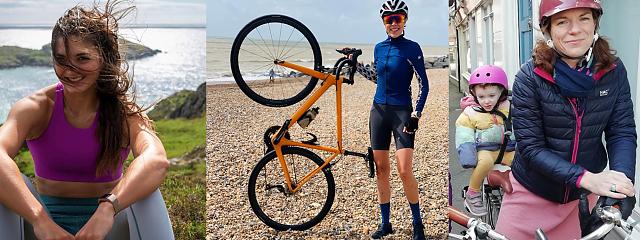

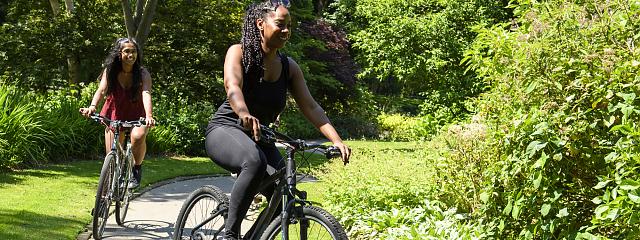
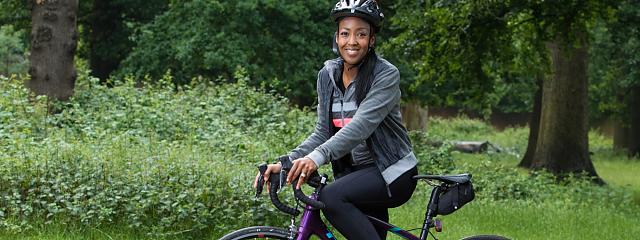
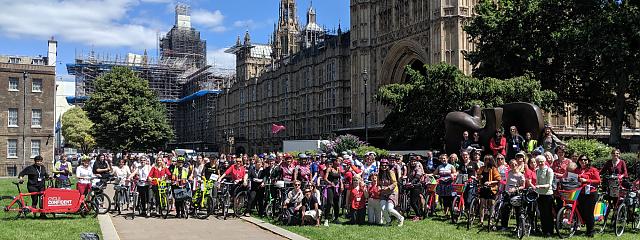
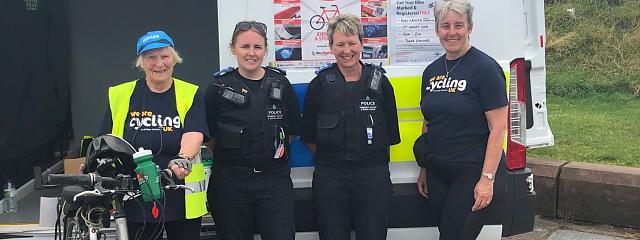



Comments
Women cycling
Ruth-Anna Macqueen is right, that far too little thought is given to practical cycling issues - and you are guilty of this too.
Many women don't use their bikes for everyday journeys because they can't carry stuff on bikes. Whether shopping, working, or for leisure, they have things to carry. Rucksacks are not the answer. Not only is it inconvenient to have to get a rucksack off your back every time you want to use it, but middle-aged and older women don't see themselves as rucksack wearers. They need encouragement & information about carriers, panniers, bags to attach to the bike. Then the shopping, papers, handbag etc just slips into the bag or pannier, and the bike carries all the weight for you.
Some will want to know about child seats and bigger things like trailers.
So let's have lots more publicity about how to make bicycles useful in everyday life.
Luggage
Halfords did a nice and practical briefcase type pannier, not robust enough for a laptop (but I would not want to subject my laptop to the bumps of the road) but certainly fine for my 3 1/2 mile commute with diary and files. And a pannier the other side for my clothes.
The problem with luggage is bikes do not come with a rack, and people think they have to have the teeny weeny under-the-saddle type bags; I'm an old fashioned girl and still have my Carradice saddle bag, and use a 'sensible' sized bag for Sunday or other leisure rides.
Beyond the bicycle
Hi Alix
Great post.
If people are on twitter they might like to check out #beyondthebicycle to see how people are using cycling beyond the usual 2 wheelers. We'd love to see some more examples out there.
Thanks
Janet
One of the problems when you
One of the problems when you are a female cyclist is buying equipment. There is much less of everything to choose from. Less bikes, less cycle shoes, and less cycle clothing. So you often have to make do with things you don't like, or things that don't fit properly.
Clothing is especially difiicult. Some of the best makes seem to make their clothing for teenage girls. Even the xl size (if you can get anything bigger than large) is too small. I am a slim size 16 for jerseys. I am not fat or even well built, I am slim, but I usually need a size 16 equivalent for tops.
Then there's styling. Those of us who are athletic often don't want pink, flowers, or tight armholes with silly little sleeves that are designed for fashion, not sport. The same goes for lengh: short lengths in tops are not helpful when you cycle seriously - or when you are tall.
Then there are bib shorts/tights. These tend to be more comfortable than waisted ones, but while there are loads for men to choose from, there are very few for women.
I can understand women who decide to leave cycling to the men who dominate it, and take up a sport that caters for sporty women!!!
Role Models
It is quiet ironic that I cycle daily to teach road safety in every school in Cardiff, since I failed cycling proficiency in school and my parent's couldn't afford me a bike, yet now I own 3.
Cycling to town was convenient for me prior to getting a car in my mid 20's, so it has since become a habit.
As a National Standards trained instructor, I have probably raised a few eyebrows as both last year and with my previous pregnancy, I was teaching Police Cyclists while I was heavily pregnant.
Indeed, when walking or driving with a bump became so painful that I was close to tears, cycling was my sanity. It also meant that I could transport my 3 year old around past my due date, rather than staying cooped indoors feeling fat, achey and depressed.
The 'Cycle Chic' website has been my inspiration. Had I not seen normal women with children, dressed in regular clothes and enjoying riding on everyday utility trips, I am sure that the bike would have become redundant once I got pregnant, and definitely once the children were born.
Let's have more 'normal' cycling examples everywhere as not every one is planning to dress for the Tour De France when they want to get from A to B!
One of the interesting things
One of the interesting things in the Census 2011 statistics is that the higher the overall rate of cycling the higher the share of women cycling.
What is not clear is the direction of causation here - is it because the infrastructure is better and designed around a broader set of needs, or is it simply that the more cycling becomes "normalised" the less of a barrier there is to getting one one's bike and the less unusual it feels?
One of the interesting things
One of the interesting things in the Census 2011 statistics is that the higher the overall rate of cycling the higher the share of women cycling.
What is not clear is the direction of causation here - is it because the infrastructure is better and designed around a broader set of needs, or is it simply that the more cycling becomes "normalised" the less of a barrier there is to getting one one's bike and the less unusual it feels?
One of the interesting things
One of the interesting things in the Census 2011 statistics is that the higher the overall rate of cycling the higher the share of women cycling.
What is not clear is the direction of causation here - is it because the infrastructure is better and designed around a broader set of needs, or is it simply that the more cycling becomes "normalised" the less of a barrier there is to getting one one's bike and the less unusual it feels?